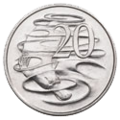Regular coinage
The Royal Australian Mint has announced that, following the death of Queen Elizabeth II in 2022, it will produce one million $1 coins bearing King Charles' face in 2023 [1] with the new effigy to fully replace a temporary memorial effigy of Queen Elizabeth II by May 2024. [2] All previous coins have featured a depiction of the monarch on the obverse. Since decimalisation, four different effigies of Elizabeth II, Queen of Australia had been used for this purpose. The first effigy was designed by Arnold Machin, the second by Raphael Maklouf, the third by Ian Rank-Broadley and the fourth by artist Jody Clark. They have all been matched with designs by the Australian-born artist Stuart Devlin on the reverse. The set now comprises a 50c, 20c, 10c and 5c coin, all still referred to as "silver", although they consist of 75% copper and 25% nickel. For many years there were also 2c and 1c coins, traditionally called "copper" coins, although they are actually an alloy of copper and zinc.
The "silver" 5c, 10c, and 20c coins can be counted by value using their weight, without the need to count the individual pieces, as they have the same weight per value, at 0.565g per cent, or 56.5g per dollar. This allows banks to count the value of a collection of any combination of those coins.
The original 50c coin was circular and contained 80% silver and 20% copper, and the metal in the coin quickly became worth more than 50c. It had almost identical dimensional specifications to the British half crown coin. However, to avoid confusion with the 20c coin, and because of its excess value, it was only produced for one year and then withdrawn from circulation. No 50-cent coins were minted for 1967 or 1968. The coin was issued in a dodecagonal (12-sided) shape starting in 1969, although the 12-sided version had been minted in 1966–67 as a specimen piece, to test the design. The standard design on both versions of the coin are the same: the obverse carries the effigy of the sovereign, and the reverse shows the coat of arms of Australia, although the coin has been issued with both standard and commemorative designs. [3]
The dodecagonal version has a mass of 15.55 g and a diameter of 31.5 mm, and the round silver version had a mass of 13.28 g and diameter of 31.5 mm. 94.13 round 50c coins make up a fine kilogram of silver.
"Gold" one-dollar and two-dollar coins were introduced in the 1980s. The one-dollar coin was introduced in 1984, to replace the banknote of the same value. The two-dollar coin, also replacing a banknote, was introduced in 1988. They have content of 2% nickel, 6% aluminium and 92% copper. The two-dollar coin is smaller in diameter than the one-dollar coin, but the two-dollar is slightly thicker.
Due to the metal exceeding face value, the minting of one- and two-cent coins was discontinued in 1991, and they were withdrawn from circulation beginning in 1992. [4] Since 1991 [update] , both coins have only been minted as collectors' items, such as in 2006 as part of a "Mint Year" set. [5] Australian coins have medallic orientation, as do most other Commonwealth coins, Japanese yen coins, and euro coins. That is in contrast to coin orientation, which is used in United States coinage.
After the death of Elizabeth II and the change of its Sovereign, new Australian coins began to be minted with King Charles III on their obverse in December 2023. The $1 coin was the first to change over, with the remaining denominations to be periodically changed based on bank demand. [6]
Table
| Image | Value | Technical parameters | Description | Date of first minting | ||||||
|---|---|---|---|---|---|---|---|---|---|---|
| Obverse | Reverse | Diameter | Thickness | Weight | Composition | Edge | Obverse | Reverse | ||
| | 1c | 17.65 mm | >1.4 mm | 2.60 g | 97% copper 2.5% zinc 0.5% tin | Plain | Queen Elizabeth II | Feathertail glider | 1966–1991 (no longer issued) | |
 | 2c | 21.59 mm | <1.9 mm | 5.20 g | Frill-necked lizard | |||||
| | 5c | 19.41 mm | 1.3 mm | 2.83 g | Cupronickel 75% copper 25% nickel | Reeded | Queen Elizabeth II (1966-2024) King Charles III [7] (2024-Present) | Echidna | 1966 | |
 | 10c | 23.60 mm | 1.5 mm | 5.65 g | Superb lyrebird | |||||
 | 20c | 28.65 mm | 2.0 mm | 11.3 g | Platypus | |||||
 | 50c | Dodecagon 31.65 mm (across flats) | 2.0 mm | 15.55 g | Plain | Queen Elizabeth II (1969-2024) King Charles III [7] (2024-Present) | Coat of arms | 1969 | ||
 | $1 | 25.00 mm | 2.8 mm | 9.00 g | 92% copper 6% aluminium 2% nickel | Interrupted milled | Queen Elizabeth II (1984-2023) King Charles III [6] (2023-Present) | Five kangaroos | 1984 | |
 | $2 | 20.50 mm | 3.0 mm | 6.60 g | Queen Elizabeth II (1988-2024) King Charles III [7] (2024-Present) | Aboriginal elder and Southern Cross | 1988 | |||
| These images are to scale at 2.5 pixels per millimetre. For table standards, see the coin specification table.Source: Royal Australian Mint. [8] | ||||||||||
- Effigy of Elizabeth II by Arnold Machin displayed on coins minted in 1966
